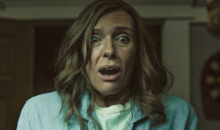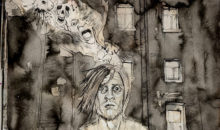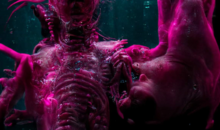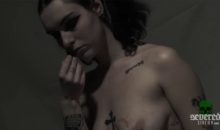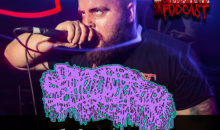Horror in Hi-8: An Interview with Brad Sykes
Brad Sykes could be called an indie legend already. The man has been involved in film for many years, but more importantly he’s the man behind the Camp Blood movies. You know the ones, those clown faced covers that stare out at you from nearly every DVD shop. Also in 2002, he released Death Factory, which in my opinion is one of the best so far in his career, along with Hi-8, the new anthology which is appearing all over horror sites, and festivals. This baby could be his crowning achievement so far. As he explains in this interview the process wasn’t a long one; everybody (including some long time indie scene talents) involved in the project were very willing to throw down and I hope it will be a light for many other indie creators to follow.
Hi Brad. Let’s start by taking you back to your early days in movies, before the famous Camp Blood creations. You paid your dues in films such as Kiss the Girls and The Killer Eye amongst others. Can you give us the story of how you raised yourself up to making your own films?
I was always interested in writing and storytelling from a young age and I started making shorts around age 15 with a Hi-8 video camera. From there, I made a few video features with my friends in high school, then went on to film school at Boston University. While there, I spent a summer in LA, where I worked on Kiss the Girls among other things. The next year, I made the big move to LA, where I continued working various production jobs till I landed my first writing/directing gig, Scream Queen with Linnea Quigley.
Cool. In at the deep end with Linnea. He he. So how do you feel about the success your underground hits have achieved like Camp Blood and The Zombie Chronicles? For instance, here in the UK I can walk into just about any DVD shop that stocks horror films and see at least one of your babies looking at me.
It’s always nice to hear that your films have been released and even have a certain degree of popularity, in other countries. I have been hearing about the UK Camp Blood DVD releases for a while and I even managed to get a few of them off Ebay. My movies, Death Factory, Goth, and Demon’s Kiss (released as Kiss Me if you Dare) were also distributed in the UK, so I’m represented pretty well over there!
Have the distributors been treating you well, or has your life of filmmaking been paved with scoundrels?
My experience has been a bit different than some indie filmmakers because many of my films were produced and financed by distributors. So for me, it wasn’t a case of getting screwed out of profits that you usually hear from indie filmmakers. The tradeoff, of course, is that you can be very restricted creatively (and financially) sometimes and many of these people are not nice to deal with at all! The positive side of it is, if the distributor is at all good at what they do, your movie will have increased visibility and often be released much sooner than a standard “pickup”. For example, when we shot Death Factory in summer 2002, we were told the DVD release would be November of the same year. And it was, in Blockbusters all over the country.
For people who haven’t seen your works, do you generally like to associate with the same people per film? Or do you like to see fresh faces every time?
It depends. I have DPs, editors, and composers who I’ve been working with, on and off, for almost 15 years now. With actors, it’s a bit more complicated, because while I have some who I’ve worked with on 4 or 5 movies, I do like to see fresh faces in my films and I always hire the best actor for the role. The problem with actors is, they tend to “disappear” more frequently than crew members, moving, changing careers, or just burning bridges with people who hired them.
When you’re not out working or promoting your movies and you’re at home, describe what you see every morning when you leave your home and if anything you see works into your works.
I try to be inspired by actual experience more than movies these days. Luckily I live in LA, which can sometimes be creatively exhausting but also inspiring if you know how to tune out the noise and take advantage of all the different cultural opportunities and varied landscapes this city offers. For example, on my new film Hi-8, we were thinking for a while of where to shoot the wraparound, which involves young filmmakers much like myself at that age and my wife/producer Josephina and I realized that Griffith Park, where we had seen several open-air Shakespeare plays over the last few years, would make a perfect setting, with its old, disused “bear caves” from the old LA zoo and other unique features. It was also, thankfully, free to shoot there with a small crew!
Anthologies have made a comeback, with The Theatre Bizarre and V/H/S for example. How does Hi-8 fit in with the short story scene? More to the point, what does Hi-8 bring to the table which the others do not?
Hi-8, which stands for both the video format, and “Horror Independent 8”, is both old school and something completely new. I say old school because all 8 stories are narrative driven, like the anthologies I like, such as Creepshow and the Amicus Tales from the Crypt. What makes it stand out, though, is the talent involved and the way we went about making the segments. A few of the 8 contributing filmmakers are SOV pioneers, such as Tim Ritter, Donald Farmer, and Todd Sheets. These are literally some of the very first indie filmmakers of the video store generation and their work goes back to the 80’s and early 90’s. Others of us, such as myself, Marcus Koch, Chris Seaver, and Ron Bonk, are sort of “2nd generation” filmmakers who started a bit later and have all achieved a cult following over the years. And Tony Masiello is a real historian of the SOV horror scene, and is producing a doc on the subject. So we have a very experienced, and eclectic, lineup of filmmakers involved. Despite all that experience, I didn’t want anyone to get too technically fancy, in fact the idea was for us all to go back to our roots and shoot on older formats (some of the directors even shot on Hi-8), with limited cast and crew, practical effects, etc. I think ultimately what Hi-8 offers the audience is a fun, unpretentious trip back in time to the video store heyday, with a variety of styles, tones, and moods, which is exactly what I hoped for.
Since you mentioned Amicus, have you ever watched the Amicus short story anthologies apart from Tales from the Crypt, such as Vault of Horror, From Beyond the Grave, etcetera?
I haven’t seen all those you listed, but I did see Tales at a young age and just loved it. All the stories are great (something hard to pull off in any anthology, back then or today), though I think my favorites are the Cushing one and the last one with the blind people. I was also a big fan of anthology style TV shows growing up — stuff like Tales from the Darkside, The Hitchhiker, Ray Bradbury Theatre etc.
How did everyone gel together as a team for Hi-8? Was it a long process to get everybody together?
It was not a long process, in fact it all happened faster than I expected. Tim Ritter and I started discussing the idea of doing the project in late 2012, and we had all 8 filmmakers on board within a month or so. We tried to impose some deadlines for everyone’s sake, and all the completed shorts were delivered by summer 2013. Then the final editing began. But our LA premiere was in November last year, pretty good for a project with so many moving parts, shot all over the country, with very little money! But so far the film has been very well-received and we look forward to getting it in front of more horror fans in 2014!
Many thanks to Brad for taking time out for Severed Cinema.









